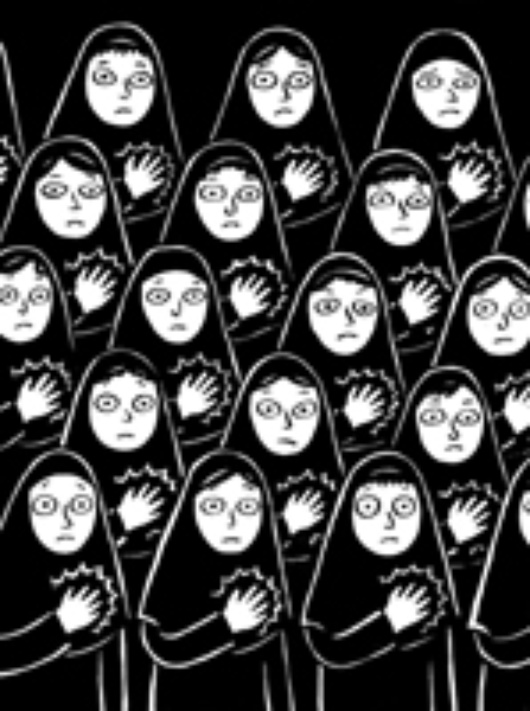Marjane Satrapi
Published on
Warm like hell…get over it. Light on Persepolis: prepare to read the first part of the essay on Marjane Satrapi. Her work recently became a movie and has been awarded at the Cannes Film Festival. Here you can find Marjane's brunch with cafebabel.
Enjoy, Nat.
Marjane Satrapi – new literary phenomenon in comics
by Igor Prassel, part one
"I cannot praise enough Marjane Satrapi's moving account of growing up as a spirited young girl in revolutionary and war-time Iran. Persepolis is disarming and often humorous but ultimately it is shattering." Joe Sacco, author of Palestine and Safe Area Gorazde
Over the last ten years the international comic strip scene has undergone a real rebirth. In the wake of Art Spiegelman and his masterpiece Maus, a comic strip story about the life of his father, a Polish Jew who survived deportation to Auschwitz, a group of authors from different parts of the world continues to present autobiographical stories in comic strip form. With his comic strip reportage in the books Palestine and Goradze, Joe Sacco, of Maltese  origin, has demonstrated that the comic can also be used as a journalistic medium and the Canadian Julie Doucet has made us grieve with the stories of her comic strip diary. The Swedes, Max Andersson and Lars Sjunesson, have mixed surrealist fiction with true life in their travelogues through the Balkans, the Croatian Helena Klakocar has given us a splendid account taken from a travelogue with her family in the Adriatic Sea at the beginning of the war in Yugoslavia and finally, a group French authors - Joelle Manix, Matt Konture, Lewis Trondheim, Joann Sfar, David B and Marjane Satrapi – have understood that the comic strip as a medium does not have to be limited only to fiction.
Marjane Satrapi chose the right moment to appear on the international scene of new comics with Persepolis, her comic strip debut in autobiographical form, which is also the first Iranian comic book (even if the first edition was published in French by the French publishers of Paris L’Association). There are many important artists in Iran in the fields of literature, cinema and caricature, but comics do not exist there and so Marjane Satrapi, influenced by the French Bande Dessinée has filled the semantic vacuum. At the beginning of her career in drawing, Marjane, who studied Fine Arts in Tehran and Art in Strasbourg, was influenced by the American graphic artist Milton Glaser and wanted to become a famous graphic designer. Her first successes came with children’s books. The decisive turning point in the life of Marjane Satrapi came when she moved to Paris where she met a group of young French artists - Joann Sfar, Émile Bravo, Christophe Blain, David B. and Emmanuel Guibert – who published comics for a living. These young men invited her to share their studio (workshop ‘des Vosges’) and in particular David B., who with his Cronaca del Grande Male, an intense autobiographical account of epilepsy experienced by his brother Jean-Christophe, opened Marjane’s eyes and encouraged her to express her story in comic strip form.
origin, has demonstrated that the comic can also be used as a journalistic medium and the Canadian Julie Doucet has made us grieve with the stories of her comic strip diary. The Swedes, Max Andersson and Lars Sjunesson, have mixed surrealist fiction with true life in their travelogues through the Balkans, the Croatian Helena Klakocar has given us a splendid account taken from a travelogue with her family in the Adriatic Sea at the beginning of the war in Yugoslavia and finally, a group French authors - Joelle Manix, Matt Konture, Lewis Trondheim, Joann Sfar, David B and Marjane Satrapi – have understood that the comic strip as a medium does not have to be limited only to fiction.
Marjane Satrapi chose the right moment to appear on the international scene of new comics with Persepolis, her comic strip debut in autobiographical form, which is also the first Iranian comic book (even if the first edition was published in French by the French publishers of Paris L’Association). There are many important artists in Iran in the fields of literature, cinema and caricature, but comics do not exist there and so Marjane Satrapi, influenced by the French Bande Dessinée has filled the semantic vacuum. At the beginning of her career in drawing, Marjane, who studied Fine Arts in Tehran and Art in Strasbourg, was influenced by the American graphic artist Milton Glaser and wanted to become a famous graphic designer. Her first successes came with children’s books. The decisive turning point in the life of Marjane Satrapi came when she moved to Paris where she met a group of young French artists - Joann Sfar, Émile Bravo, Christophe Blain, David B. and Emmanuel Guibert – who published comics for a living. These young men invited her to share their studio (workshop ‘des Vosges’) and in particular David B., who with his Cronaca del Grande Male, an intense autobiographical account of epilepsy experienced by his brother Jean-Christophe, opened Marjane’s eyes and encouraged her to express her story in comic strip form.
Go to the part two…
Credits
"Il velo di Maya o dell'ironia dell'Iran", Elettra Stamboulis e Gianluca Costantini, MIRADA cultural association, Ravenna, 2003.
Igor Prassel is member of Stripburger, Slovenian magazine of culture and comics.



